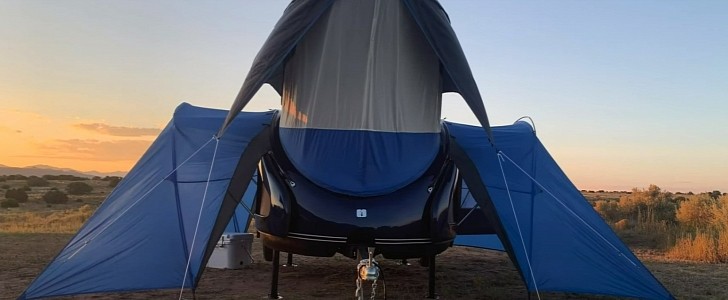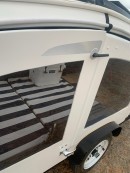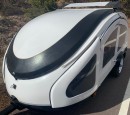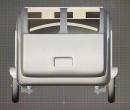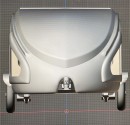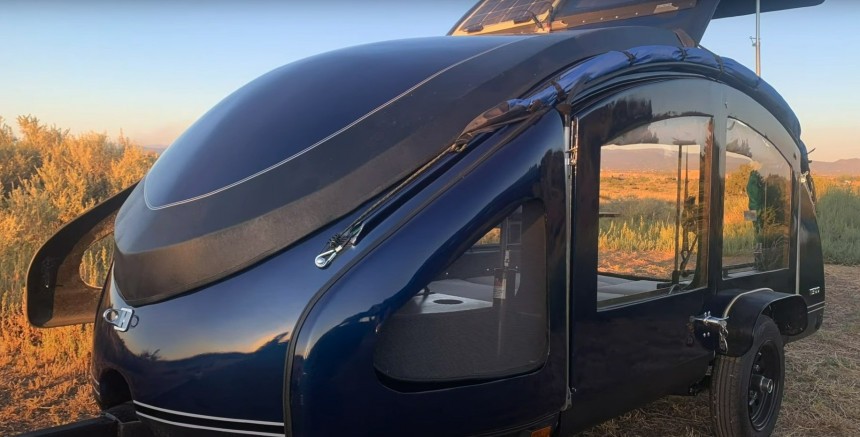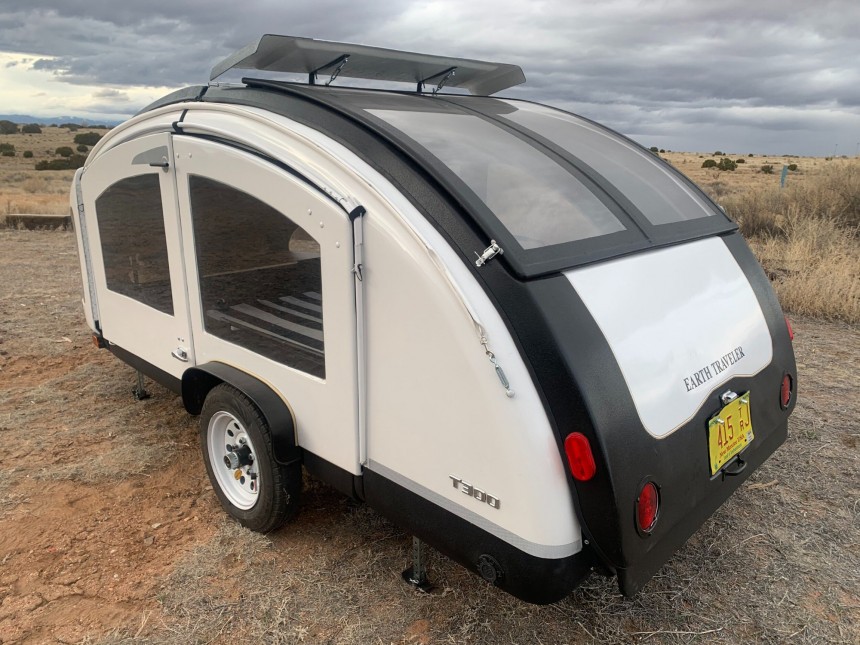So, you think you’ve seen it all until you run across a teardrop camper made of friggin feathers! No joke. The team trying out this innovative material is New Mexico-based Earth Traveler.
Ladies and gents, this may be one of the most oddly innovative teardrop designs to date. It’s called the Earth T300 and is a teardrop camper like none other I've run across. I’ve heard of campers made of carbon fiber, and I've heard of campers made of fiberglass or other fiber and resin mixtures, but the T300 is made of feathers. Yes, like the kind you find on birds.
Earth Traveler saw its beginnings back in 2014 with a need to find a trailer that could fit a family of four and be towed by nothing more than a Fiat 500. Having found none around, founder Angel Irlanda decided to get to work building his own. Once family and friends started asking for one themselves, Irlanda decided it’s time to start a business. With a construction based on principles of biomimicry, this company now produces only two camper options.
Back to the T300, why the heck feathers? It’s simple. Humans have been using feathers for a multitude of solutions for thousands of years. One recent development happening in the world of science is that of taking feathers, isolating the protein from them, and using that protein for food production.
As for using this material in camper construction, Irlanda chose the feather for a multitude of reasons. Because of their structure, feathers are light, have exceptional insulating properties, and are even known to repel water. Did I mention feathers can be quite affordable to acquire? Oh, and under the right conditions, feathers can decompose about 80% in just 48 hours.
However, feathers aren’t the only component making up the T300. Fiberglass, wood, Kevlar, carbon fiber, and of course, resins to hold it all together are at play. Together these materials build a vehicle suitable for a family of four weighing as little as 300 lbs (136 kg)—hence the name.
The camper is set upon a Timbren axle-less suspension with a 1,200-lb (544-kg) capacity and SumoSprings Trailer helpers with 2,000-lb (907-kg) capacity. Closed, the trailer is 5 feet (1.5 meters) wide, 5 feet (1.5 meters) tall, and 11 feet (3.35 meters) long. When open, you’re looking at a width of 11 feet (3.35 meters), height of 7 feet (2.13 meters), and length of 11 feet (3.35 meters).
A couple more add-ons included in the T300 are pop-up roofs, front and back, insulated ceiling and walls (not that they would do much when out in the wild), and two large outdoor lounge cushions also used as the main bedding.
Even though the interior of the T300 includes nothing more than space, a battery, and some LED lights, that makes it perfect for decking it out just to your liking. There's plenty of room to bring clothing, gear, and possibly an outdoor shower and even a portable toilet. I’m sure you can even figure out a way to equip the camper with solar power and inverter.
Ready for the best part of it all? As it stands, the T300 unit starts at just $10,000 (€8,439 at current exchange rates). That's all the money you’ll need to get yourself a teardrop camper that is so light it could fly. Oh, and don’t forget about all the conversations you'll spark because your camper is made from feathers.
Earth Traveler saw its beginnings back in 2014 with a need to find a trailer that could fit a family of four and be towed by nothing more than a Fiat 500. Having found none around, founder Angel Irlanda decided to get to work building his own. Once family and friends started asking for one themselves, Irlanda decided it’s time to start a business. With a construction based on principles of biomimicry, this company now produces only two camper options.
Back to the T300, why the heck feathers? It’s simple. Humans have been using feathers for a multitude of solutions for thousands of years. One recent development happening in the world of science is that of taking feathers, isolating the protein from them, and using that protein for food production.
However, feathers aren’t the only component making up the T300. Fiberglass, wood, Kevlar, carbon fiber, and of course, resins to hold it all together are at play. Together these materials build a vehicle suitable for a family of four weighing as little as 300 lbs (136 kg)—hence the name.
The camper is set upon a Timbren axle-less suspension with a 1,200-lb (544-kg) capacity and SumoSprings Trailer helpers with 2,000-lb (907-kg) capacity. Closed, the trailer is 5 feet (1.5 meters) wide, 5 feet (1.5 meters) tall, and 11 feet (3.35 meters) long. When open, you’re looking at a width of 11 feet (3.35 meters), height of 7 feet (2.13 meters), and length of 11 feet (3.35 meters).
Even though the interior of the T300 includes nothing more than space, a battery, and some LED lights, that makes it perfect for decking it out just to your liking. There's plenty of room to bring clothing, gear, and possibly an outdoor shower and even a portable toilet. I’m sure you can even figure out a way to equip the camper with solar power and inverter.
Ready for the best part of it all? As it stands, the T300 unit starts at just $10,000 (€8,439 at current exchange rates). That's all the money you’ll need to get yourself a teardrop camper that is so light it could fly. Oh, and don’t forget about all the conversations you'll spark because your camper is made from feathers.
